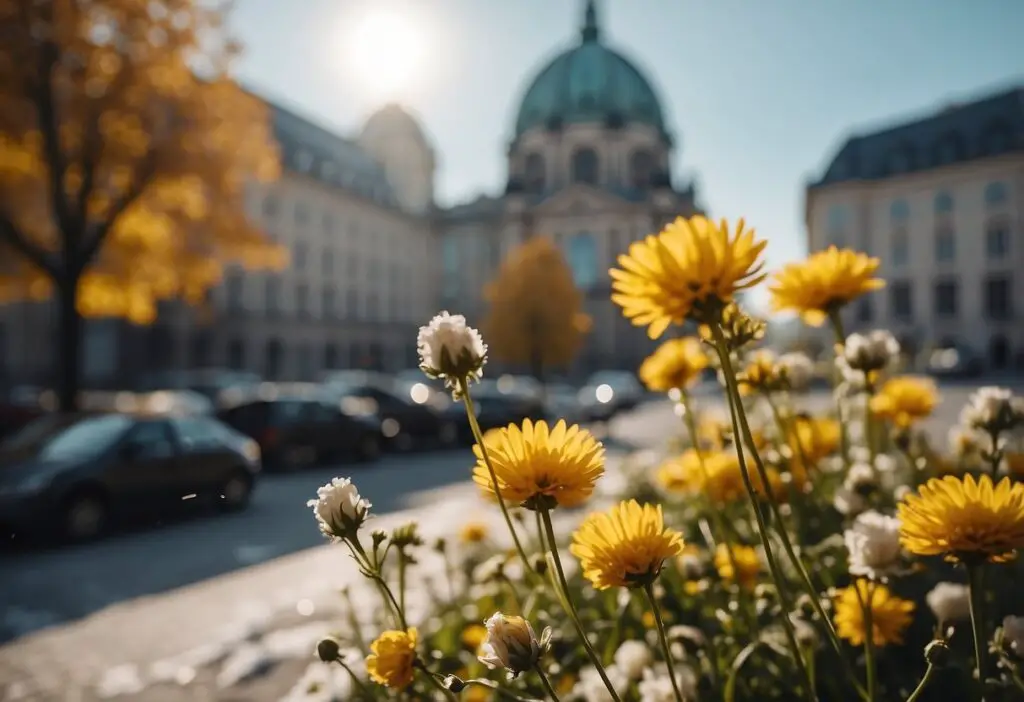Discover the best time to visit Berlin, Germany, which offers unique experiences throughout the year. Whether you’re drawn to the vibrant summer festivals or the enchanting winter markets, our guide will help you find the perfect season to explore Berlin’s rich culture and history. Get ready to plan an unforgettable trip to this dynamic and historic capital.
Best Times to Visit Berlin by Season

Spring in Berlin: Bloom and Festivals
Spring in Berlin is all about blossoming trees and vibrant festivals. In March, the city starts to warm up, with cherry blossoms decorating streets and parks. The weather becomes mild, making it ideal for outdoor activities. One of my favorite events is the Cherry Blossom Festival, where you can stroll through beautiful gardens.
In May, the Carnival of Cultures celebrates Berlin’s diverse community. It’s a spectacular event with parades, music, and food worldwide. Don’t miss Easter festivities, where local markets offer handmade crafts and delicious treats.
Summer in Berlin: Parks and Open-Air Events
Summer is arguably the best time to visit Berlin, Germany, especially for those who love the outdoors. From June to August, the city comes alive with sunny days and warm nights. Parks like Tiergarten are perfect for picnics and leisurely walks. The warm weather encourages spending time outside, whether at beer gardens or enjoying street music.
Many festivals occur in the summer, such as Fête de la Musique and Christopher Street Day (CSD), Berlin’s pride parade. Evening events like the Classic Open Air concerts add a magical touch to warm summer nights, making it a season full of vibrant nightlife and city exploration.
Fall in Berlin: Colors and Culture
Autumn is a cultural feast in Berlin. The leaves turn golden by late September, and the city air gets crisp. The weather remains comfortable, allowing plenty of outdoor activities without the summer crowds. Berlin Art Week and the Festival of Lights are major attractions, showcasing the city’s artistic side through exhibitions and stunning light displays.
October and November bring cooler temperatures, but exploring Berlin’s many parks and gardens is still pleasant. This shoulder season offers a quieter experience while enjoying the rich autumn colors.
Winter in Berlin: Christmas Markets and Cozy Corners
Winter in Berlin transforms the city into a winter wonderland. The city is adorned with Christmas lights and festive decorations from December to February. The weather is cold, often snowy, creating a cozy atmosphere ideal for wandering through traditional Christmas markets.
These markets, like the famous one at Gendarmenmarkt, are perfect for finding unique gifts and savoring seasonal treats. January and February are the coldest months, so bundle up with a warm jacket. Despite the chilly weather, Berlin remains vibrant with New Year celebrations and indoor cultural events, offering warmth and cheer on the frostiest days.
Planning Your Trip: Accommodation and Crowds

When planning my trip, I quickly realized that the best time to visit Berlin, Germany is crucial for a smooth experience. From bustling events to quieter shoulder seasons, timing makes all the difference.
Berlin is packed with visitors during the high season (June to August). Hotel rates and airfare are expensive, but the vibrant atmosphere is unmatched. Events like Berlin Fashion Week and the Carnival of Cultures draw large crowds. Locals and tourists flock to restaurants, nightlife spots, and outdoor festivals.
For a more peaceful experience, I recommend visiting during the shoulder seasons. Both spring (March-April) and autumn (October-November) offer moderate weather, fewer crowds, and lower accommodation costs. These periods allow a relaxed exploration of Berlin’s rich cultural landscape without the bustle.
Winter is an option if you don’t mind cold weather. Except for the busy Christmas period, this season sees fewer tourists. Some hotels offer great deals, making it an ideal time to explore Berlin’s history and indoor attractions.
Here’s a quick breakdown of the seasons and their characteristics to help with your planning:
| Season | Crowds | Hotel Rates | Events |
|---|---|---|---|
| High Season (Jun-Aug) | Crowded | Expensive | Fashion Week, Carnival of Cultures |
| Shoulder Season (Mar-Apr, Oct-Nov) | Moderate | Affordable | Peaceful Exploration |
| Winter (Excluding Christmas) | Few tourists | Cheapest | Indoor Attractions |
By timing my visit carefully, I found a balance between lively events and serene sightseeing, making the most of my trip to this diverse city.
Cultural Highlights and Seasonal Activities

Visiting Berlin is a treat any time of year, but knowing the best time to visit Berlin, Germany, can enhance your experience with its rich culture and diverse activities.
I love exploring the Berlin Art Week and the Gendarmenmarkt in the spring. The weather is perfect for biking around the city and visiting historical sites like the Brandenburg Gate.
Summer is a prime time for outdoor festivals. The Fête de la Musique fills the streets with music, while Berlin’s lakes offer a refreshing retreat. At night, open-air raves in Kreuzberg transform the city into a lively party scene.
Fewer tourists make it easier to enjoy cultural landmarks and museums in autumn. The Festival of Lights illuminates Berlin’s iconic buildings, and Mitte’s vibrant nightlife keeps the energy up.
Winter brings charming Christmas markets and the magical atmosphere of Berlinale. The cold is a small price for the festive vibes and fireworks.
Berlin offers something unique every season, whether you’re interested in art, historical sightseeing, or lively festivals.
What month is best to visit Berlin?
The best month to visit Berlin is May, when the weather is pleasant and the city hosts numerous outdoor events and festivals.
How many days in Berlin is enough?
Three to four days in Berlin is enough to explore its major attractions, enjoy its culture, and get a good feel for the city’s unique atmosphere.
What month is the best time to go to Germany?
The best time to visit Germany is May to September when the weather is mild, the days are long, and there are a variety of festivals and outdoor activities.
Which month is coldest in Berlin?
The coldest month in Berlin is usually January, with temperatures often dropping below freezing and occasional snow.
If you liked this blog post about the topic: Best time to visit Berlin Germany, don’t forget to leave us a comment down below to tell us about your experience with it.






